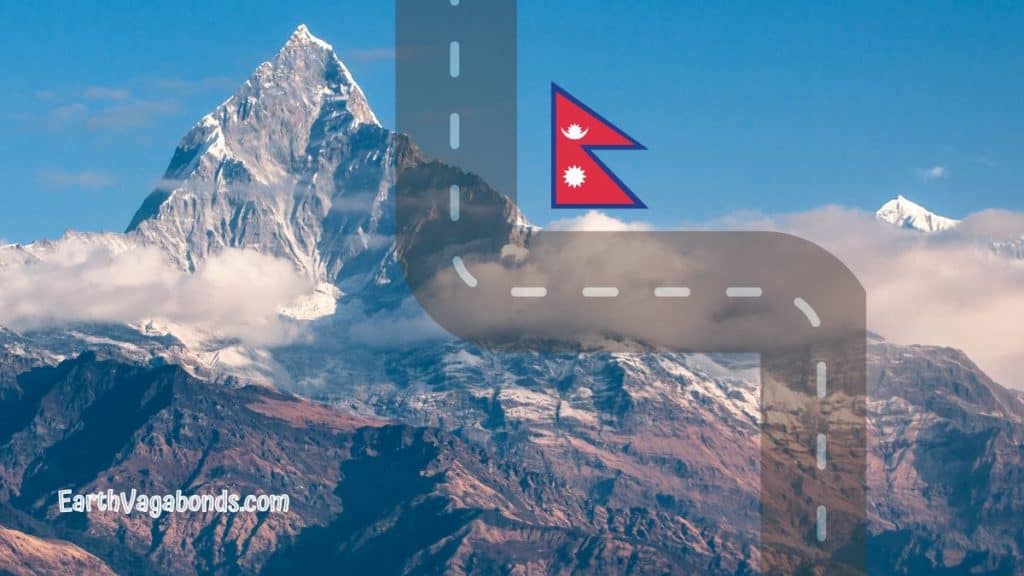Last Updated on October 25, 2024 by Ellen
This is a travel tale about a border crossing with bumps in the road we didn’t expect. It is about our journey from Rishikesh to Pokhara (India to Nepal) through a confusing land crossing and onto a northbound roadway that is the worst long-distance road we have ever traveled in a foreign country. That’s saying a lot, because we’ve traveled continuously since 2015, including a long stay in rural Philippines during the pandemic.
I hope this budget travel tale will warn others about the arduously long (46 hours!) and bumpy road we experienced. And I’ve discovered the journey north to Pokhara from Sonauli/Belahiya won’t get any easier any time soon.
If you’re not in a rush, and you have mega patience, you might enjoy this experience. Otherwise, a different border crossing or extra money for a flight into Kathmandu is worth consideration.
Rishikesh to Pokhara part 1: India side
Rishikesh / Haridwar to Gorakhpur
Americans get 180 days at a time on each visit to India on tourist visas. When our time was nearly up, we were in Rishikesh, not too far from Nepal.
Rishikesh has a small train station but not many trains go in and out each day. We hired a rickshaw to take us to the larger city of Haridwar to get a train to Gorakhpur. The rickshaw ride cost 1,200 Indian rupees ($14.67) for the three of us (me, spouse Theo, and his mom, Diane). It was a one-hour bouncy journey.
We spent a few hours around the ghats (steps to the Ganges River) before our train from Haridwar to Gorakhpur. Train tickets cost $13.25 each, which we bought several weeks in advance.
The overnight train ride was two hours late, which put us behind schedule. This particular train was dirtier than other rides (see more on trains in our other post). Also, we were short a pillow, so I used my coat.
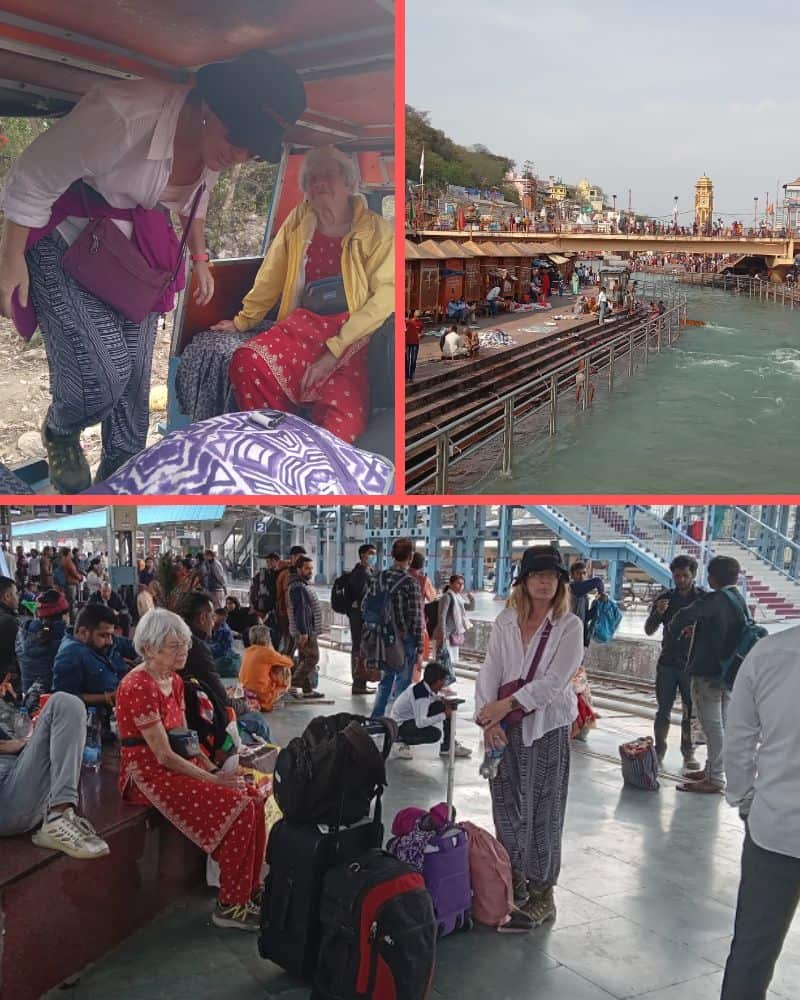
Gorakhpur to Sonauli
In Gorakhpur, we split from Mom Diane. She joined us in January so she didn’t need a border run, and she didn’t want to go to Nepal again (she’s been before). She’s traveling around India, and we will rejoin her in Kolkata when our 30-day Nepal tourist visas are up.
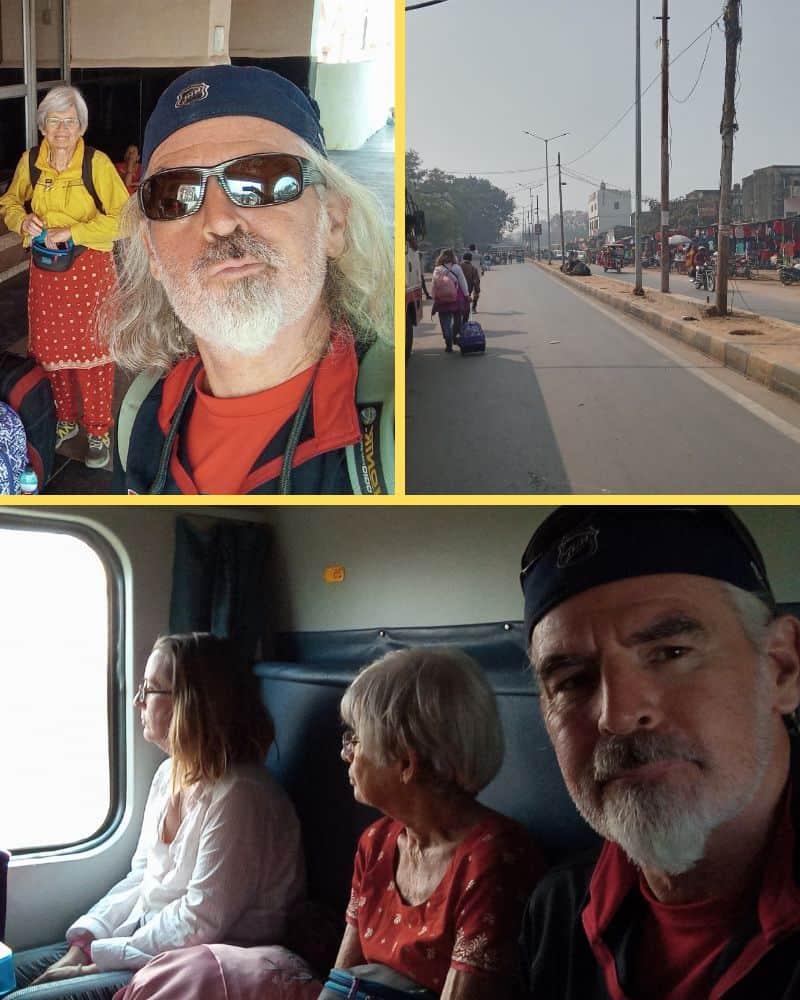
From Gorakhpur, Theo and I took a bus to the Indian border town of Sonauli. It cost a total of 320 Indian rupees ($4). Travel note: the bus ‘station’ in Gorakhpur isn’t really a station. Buses simply park on a street a short walk from the train station.
This ride was pleasant enough – we are used to public transport in foreign countries as the only Caucasians.
At the border in Sonauli, the Indian immigration office was rather far from actual border crossing. It would have been cumbersome on foot with our luggage.
A bicycle rickshaw driver offered to take us to get stamped out of India, and then take us to get stamped into Nepal. His only knew key English words about this process. When I asked his name, he didn’t understand at first.
Theo haggled the driver down from his asking price of 300 rupees ($3.65) to 200 rupees ($2.45). However, because of Arun’s knowledge of this complicated land crossing, we ended up giving him 500 rupees ($6.10). Arun was thrilled: “Very nice money!”
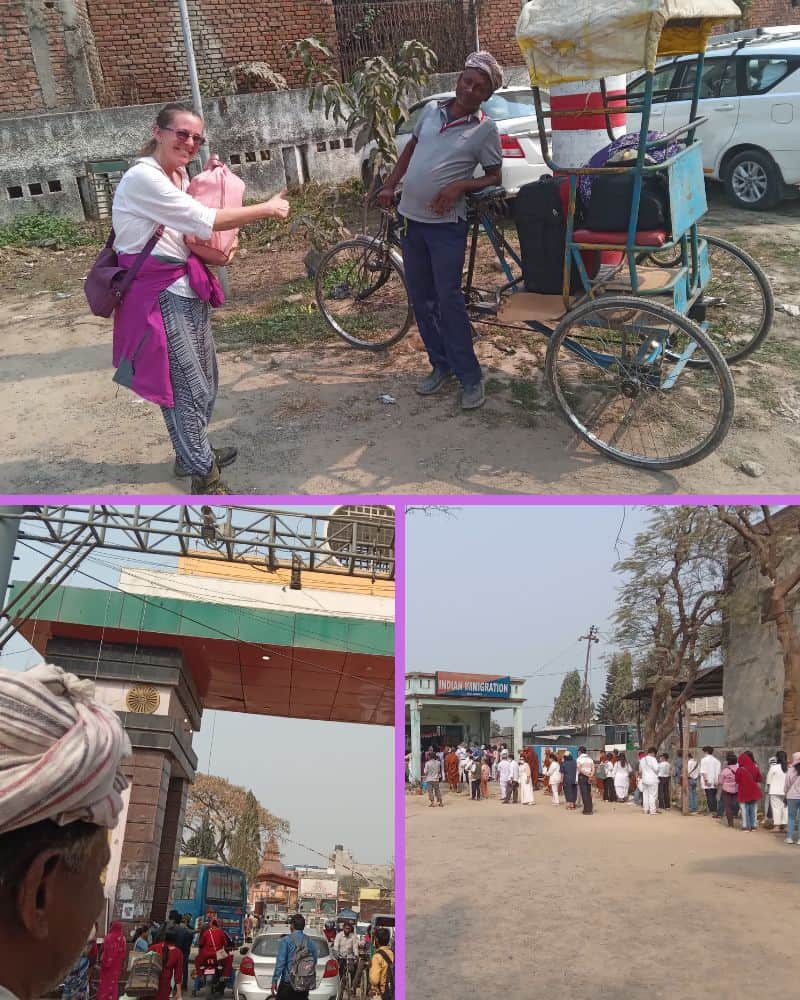
Land border crossing: Sonauli, India to Belahiya, Nepal
It seems the Indians have some type of agreement with Nepal about letting rickshaw drivers take tourists across the border with no hassle. We’ve never seen such a set up – anywhere on Earth.
Arun took us through the maze and to Nepal’s doorstep:
- first Arun took us to get stamped out of India at the Indian immigration office
- he also showed us how to cut a long line of Thai tourists at that office
- Arun took us a kilometer down the road to the actual border crossing
- on the Nepal side, Arun took us to a tent-like stand where Theo showed our passports to a man, while I waited with Arun
- we went next door to a Nepal ‘tourist’ police station next so we could to ‘sign in’ — again with our passport numbers
- these steps on the Nepal side came before immigration
- Aurn then took us a couple of buildings down the road to the actual immigration office a little further down the road
With not many signs or instructions around, navigating these steps on our own would have taken all day. Arun was kind and helpful, and we wish him well.
Rishikesh to Pokhara part 2: Nepal immigration
This was an unusual experience.
- We used a kiosk computer to enter passport info, names, travel plans, and more.
- Then we had to take pictures of the screens on our phones – the immigration officer said it was for our records.
- Next, we paid $50 each to a man outside the office – the official price to enter Nepal. He stuffed the money into his pocket and gave us a receipt to take to a second office.
- We waited several minutes for a worker to appear. We were ‘stamped in’ just as the Thai tourists began to arrive.
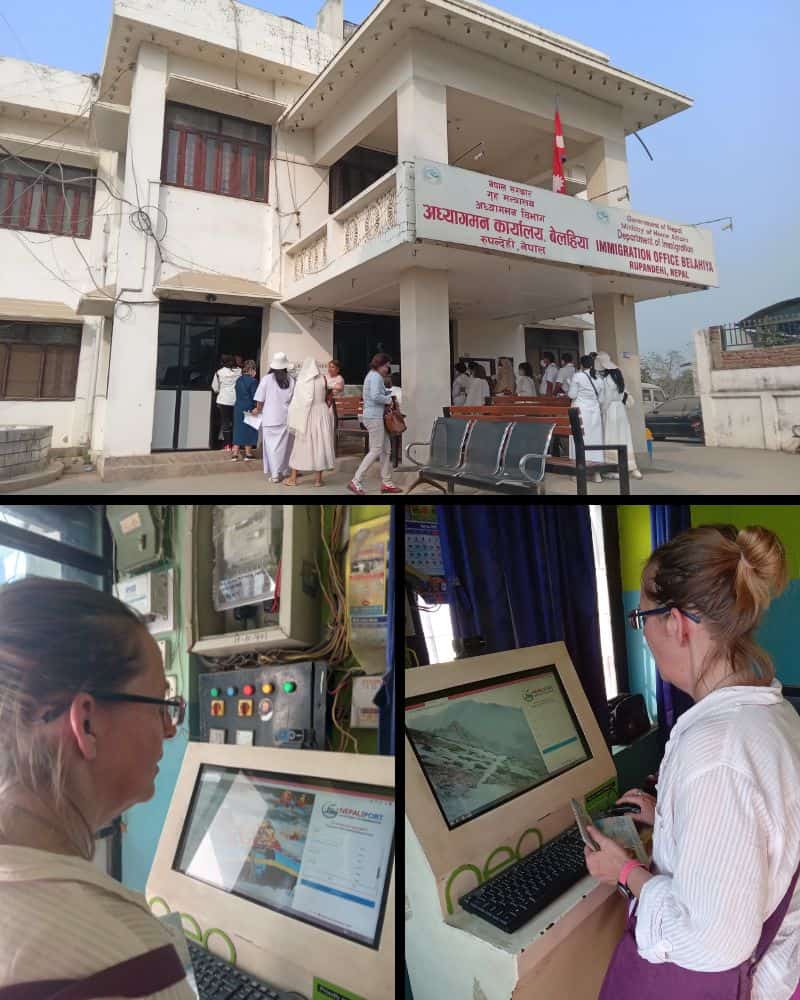
From Belahiya to Butwal
By this time, it was after 3:00 p.m. A man from a snack stand near the immigration office approached us. He said there were no more buses to Pokhara until that evening. However, he would be happy to sell us seats in a private shared bus bound for Pokhara at 5:00 p.m. The price was 1,250 Nepalese rupees ($9.50) for a non-AC bus, or 1,500 Nepalese rupees ($11.50) for an AC bus. Either bus would arrive in Pokhara around midnight, he said.
We thought he was trying to get one over on us, so we politely refused. There had to be more buses to such a tourist spot as Pokhara – Nepal’s second largest urban center!
I waved down a smaller-sized, modern-looking bus on the main road. It turned out to be the town’s only electric local bus. The conductor said he could take us to Butwal, where we could get a larger bus the rest of the way to Pokhara. Great! We hopped on, paid 90 Nepalese rupees each, and in an hour we arrived at the Butwal bus station.
Butwal bus station adventure
Spouse Theo asked around and unfortunately found our options were limited, to say the least. An early evening local bus with many stops would arrive in Pokhara around 6:00 the next morning. Or, we could take the ‘AC’ bus that left at 8:30 p.m. and arrived at ‘1, 2, or 3 in the morning.’ The AC bus tickets were 1,130 Nepalese rupees each ($8.75) — nearly the same price as the proprietor back at the snack stand had offered – the one we turned down.
It turns out that 1,130 rupees for the shared private ride from Belahiya to Pokhara was not outrageous. In fact, it was a bargain, especially when you read what happens next. Would that private ride have really gotten in by midnight? Maybe, maybe not. But it likely would have gotten to Pokara some hours before we eventually did.
Clean underwear
At this point, I needed a clean space to change my underwear. I was on 28 hours of auto and bicycle rickshaws, buses and trains. All public bathrooms were small pit toilets in wet, dirty conditions.
A local hotel near the Butwal bus station let me use a vacant room to change. Life saver! This is an option for female travelers on long journeys in developing nations without clean facilities.
I felt much better. My patience restocked.
We waited in the lounge area of that hotel for 2.5 hours for the 8:30 p.m. bus to Pokhara. Theo had beer, I had soda. We ate snacks and used the WiFi – our Indian SIM cards now useless.
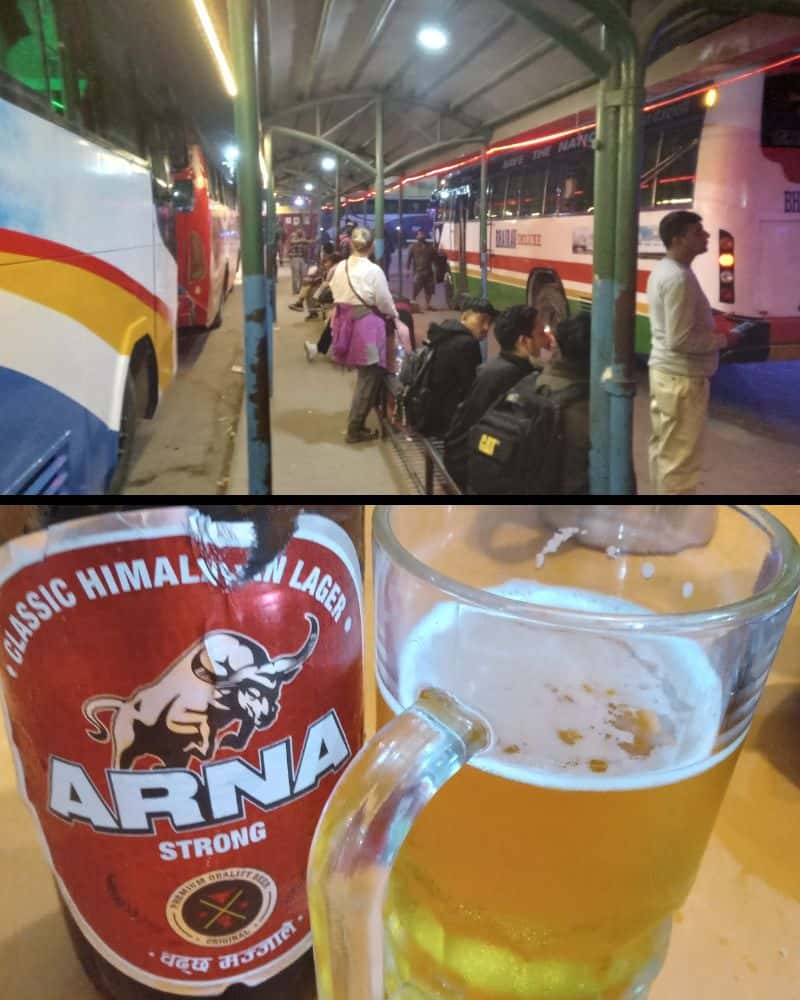
Waiting and waiting… and waiting
Back at the station, our bus was late. We waited longer… it was… a ‘dull’ wait.
We watched filthy young men (teens?) laying underneath buses with grease guns, apparently shooting jelly into unseen undersides. Theo thought this was funny. He made jokes: hoping they checked the brakes, wondering if they were old enough to be mechanics, etc.
One bus pulled up at the spot where our bus was expected. The conductor yelled “Pokhara, Pokhara!” I showed him my ticket, and he waved me on. Theo stayed outside to determine if our luggage would get placed in an undercarriage. Inside, women sat in our numbered seats. I showed them our tickets, politely asked them to move. They looked at the tickets – and told me I was on the wrong bus!
Back outside, the conductor didn’t apologize – he simply looked at me with a blank, dull stare.
The ‘road’ to Pokhara from Butwal – the biggest problem
When our bus finally came, the road to Pokhara was tough, slooooow going. We have been in economically disadvantaged countries around the world with poor road conditions. This one was by far the worst.
It was dark, and so I couldn’t get a good picture, but imagine a narrow twisting road under road construction…. for 200 miles!
Ripped up roadway with stones and dirt, gigantic potholes, with heavy equipment off to the side every few miles. A complete mess. Bumps in the road were extreme. I could have been inside a car-crushing ‘Monster Truck’ at a stadium in Indiana.
We remembered the young, thin, dirty men with grease guns. “The joke’s on me,” Theo said. The suspensions need grease every trip.
Stopping and stopping… and stopping
Just when we thought we couldn’t go any slower, we stopped. We had been on the road for 45 minutes, yet it was now was time for the driver’s dinner, apparently. I thought Theo was about to have a meltdown as the stoppage passed the 40-minute mark. His protestations about stopping for as long as we’d been going were loud.
I think this is when I decided to laugh it off. What else could be done? And I’m usually the grumpy one!
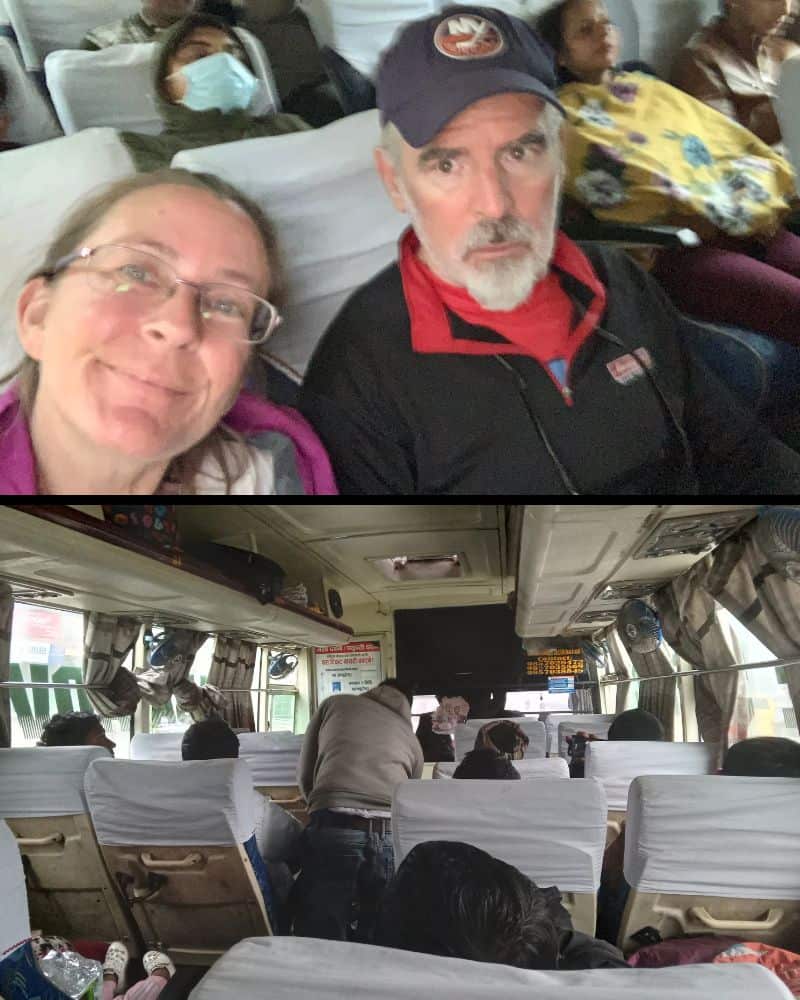
We stopped a couple of more times before 11:30 p.m., and then finally drove until about 5:00 a.m. Well, crawled. On a road that was under construction — a road that felt like it was a moonscape.
I haven’t even told the whole story – old ladies sitting on my luggage, drunk passengers puking two rows behind us.
Daybreak
At daybreak, we stopped yet again. I could finally see road in the daylight. It was as I had pictured it. The road was being widened, with huge chunks of earth cut out from steep hills. Giant falling rocks made giant potholes. Big loose stones everywhere. I was glad I hadn’t been able to see all night during the ride in the worst parts. The road gradually improved approaching Pokhara by the time daylight hit.
I wondered how in the world this major road could be in such bad shape.
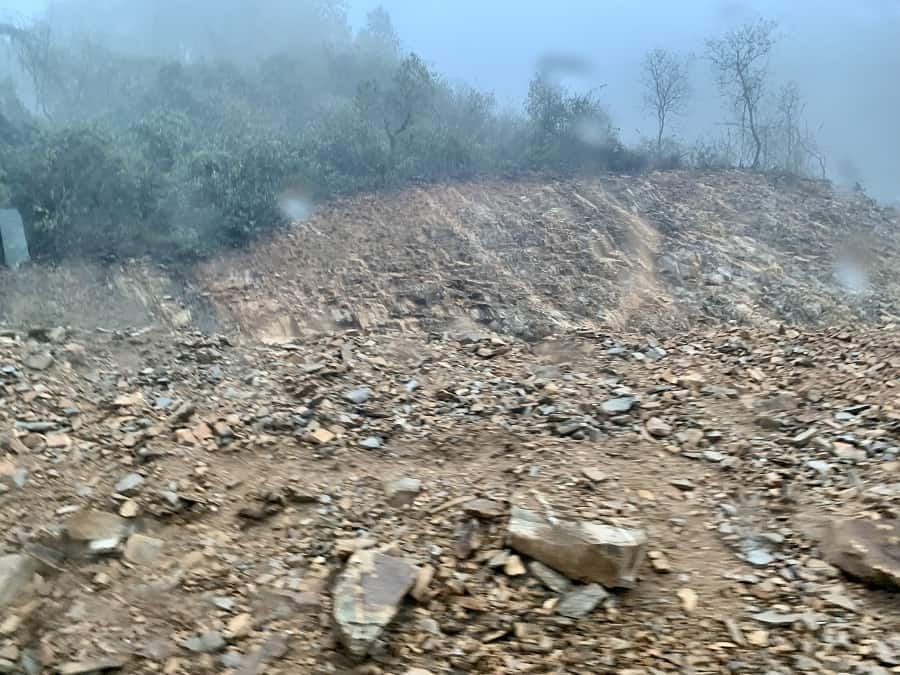
We took a taxi from the center of Pokhara to the Lakeside neighborhood for 300 Nepalese rupees ($2.30). We finally arrived at our Airbnb rental 46 hours after the start of this journey.
Part 3: Geopolitical plot twist
After some rest, I looked up what the heck was going on with this horrendous road. The revelation made me feel so sorry for Nepalese people.
Chinese contractors
Nepal awarded this major road-widening bid to a Chinese contractor several years ago. The project has been plagued with delays, money issues, and other problems. One news report: “…the construction company has managed (to finish) just 18 per cent … by the final deadline.” The deadline was August 2022.
The government agency overseeing the work said the agreement would be terminated if the contractor didn’t step up. But then what? The road is in shambles. The same report says aside from dust pollution, “accidents have soared.”
Other news reports talk about sections of the road closed at night for random construction efforts. These closures could have been why our driver took so many breaks at the beginning of the journey.
Yet another news report on one section of the project has pictures of what I (thankfully) couldn’t see at night.
Pokhara International Airport
I also read about another infrastructure project in Nepal contracted with a Chinese company: the new Pokhara International Airport. Indian media quote insiders who claim the new airport is a big money-loser for airlines. Insiders call the new airport a ‘white elephant’ due to the airport’s flight limits because of tough terrain.
Not to mention Pokhara was already challenging for pilots.
Chinese influence
Nepalese economists say several Chinese projects in the country add up to a potential debt trap, just like in Pakistan and Sri Lanka.
It’s a geopolitical dance for power as Nepal tries to modernize its infrastructure.
Nepal is a young democracy. Its 2007 interim constitution became permanent in 2015.
Nepal’s ambassador to China (himself a Communist Party member in Nepal’s democracy) gave an interview to the Kathmandu Post: ‘China’s projects don’t always get conducive environment in Nepal’.
It is a fascinating read… in fascinating times.
Bumps in the road
My privileged American ass took a long, bumpy bus ride from the Indian border to the Nepalese city of Pokhara. It was cheap. I’m safe. I cannot really complain. The road mess impacted a single day in my life. People who live near this stalled construction are impacted every single day.
Still, the next time we enter Nepal, if that road isn’t done, we won’t go that way.
At least the democratic government is trying to build up the country’s infrastructure to support easier lives for its citizens. Nepal’s terrain is not easy.
On the Nepal buses and in Pokhara, we’ve met lovely Nepalese people who were thrilled to find out we Americans are visiting despite lingering COVID issues, inflation everywhere, and ongoing infrastructure challenges.
We hope we are good unofficial American ambassadors — simply average global citizens who want to travel and learn about other cultures.
We travel ‘like locals’ to learn – and that’s what keeps us Earth Vagabonds going, despite bumps in the road.

